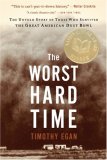Summary | Excerpt | Reviews | Beyond the Book | Readalikes | Genres & Themes | Author Bio
The Untold Story of Those Who Survived the Great American Dust Bowl
by Timothy Egan

Critics' Opinion:
Readers' Opinion:
First Published:
Dec 2005, 320 pages
Paperback:
Sep 2006, 352 pages
 Book Reviewed by:
Book Reviewed by:
BookBrowse Review Team
Buy This Book
The ranch land was empty. No people. No bison. No roads. No
farms. Just grass — three million acres of it.
"Those salubrious seasons at the end of the Eighties made that
country appear a paradise," wrote one early rancher, Wesley L. Hockett.
At dusk, when the sky burned pink against the expanse of sod, a
cowboy could be moved to tears, it was so pretty. Much of the XIT was in the
heart of the Llano Estacado, where the Comanche had roamed. And like the
Comanche, the cowboys developed their own sign language to communicate
over distances. The syndicate stocked the grassland with cattle, erected
windmills in order to pump water up for the animals, and fenced it. Barbed
wire was invented in 1874, and by the early 1880s ranchers were stringing it
across the plains, closing off the free grass. In 1887, there were 150,000
head of cattle on the XIT ranch and 781 miles of fence. It was soon the
biggest ranch in the world under fence.
The XIT was lord of the Panhandle. Not just the landowner, but
also the law. They formed vigilante posses to chase down people who
encroached on the ranch or stole cattle, and spread poison to kill wolves and
other animals with a taste for XIT calves. When railroad feeder lines came to
the ranch, the cattle shipping points were made into towns, which brought
merchants, ministers, and other hustlers of body and soul. It was a good life
for a cowboy, earning about thirty dollars a month fixing fences, riding herd,
eating chow at sunset. A black cowboy, or Mexican, had more trouble. A
man everybody called Nigger Jim Perry was the lone black cow puncher on
the XIT.
"If it weren't for this old black face of mine," said Perry, "I'd be
foreman."
The XIT prohibited gambling, drinking of alcohol, and shooting
anything without permission. Outside the ranch borders, little rail towns
sprang up with a different set of laws. One of those was Dalhart, which was
born in 1901 at the intersection of two rail lines, one going north to Denver,
the other east to Liberal, Kansas. In Dalhart, an XIT cowboy could get a
drink, lose a month's salary in a card game, and get laid at a shack known
simply as the Cathouse.
But even with the finest grass in the world, with 325 windmills
sucking water up from the vast underground aquifer, with the elimination of
predators, with several thousand miles of barbed wire, and with martial-law
control over rustlers, the biggest ranch in Texas had trouble making a profit.
The open range, on the neighboring plains states, was stocked with far too
many cattle, causing prices to crash. The weather might display seven
different moods in a year, and six of them were life-threatening. Droughts,
blizzards, grass fires, hailstorms, flash floods, and tornadoes tormented the
XIT. A few good years, with good prices, would be followed by too many
horrid years and massive die-offs from drought or winter freeze-ups, making
shareholders wonder what this cursed piece of the Panhandle was good for
anyway. Bison have poor eyesight and tend to be clannish, but they are the
greatest thermo-regulators ever adapted to the plains, able to withstand
temperatures of 110 degrees in summer, and 30 below zero in winter. But
cattle are fragile. The winter of 1885–1886 nearly wiped out cattle herds in the
southern plains, and a second season of fatal cold the next year did the
same thing up north. Cowboys said they could walk the drift line, where snow
piled up along fences north of the Canadian River, for four hundred miles, into
New Mexico, and never step off a dead animal.
With the British investors pressing for a better return on their
piece of unloved and nearly uninhabited Texas, the syndicate turned to real
estate. The problem was how to sell land that only an herbivore with hooves
could love. Parts of the XIT were scenic: little pastures near a spring, red
rock
and small canyons to break the ironing board of the High Plains. There was
some timber in the draws, but not enough for fuel or building material. What
fell from the sky was insufficient to grow traditional crops. And the rate of
evaporation made what rain that did fall seem like much less. It takes twenty-two inches in the Panhandle to deposit the same moisture as fifteen inches
would leave in the Upper Mississippi Valley. The native plants that take hold,
like mesquite, send roots down as far as 150 feet.
Copyright © 2005 by Timothy Egan. Reprinted by permission of Houghton Mifflin Company.





The House on Biscayne Bay
by Chanel Cleeton
As death stalks a gothic mansion in Miami, the lives of two women intertwine as the past and present collide.

The Flower Sisters
by Michelle Collins Anderson
From the new Fannie Flagg of the Ozarks, a richly-woven story of family, forgiveness, and reinvention.

The Funeral Cryer by Wenyan Lu
Debut novelist Wenyan Lu brings us this witty yet profound story about one woman's midlife reawakening in contemporary rural China.
Your guide toexceptional books
BookBrowse seeks out and recommends the best in contemporary fiction and nonfiction—books that not only engage and entertain but also deepen our understanding of ourselves and the world around us.